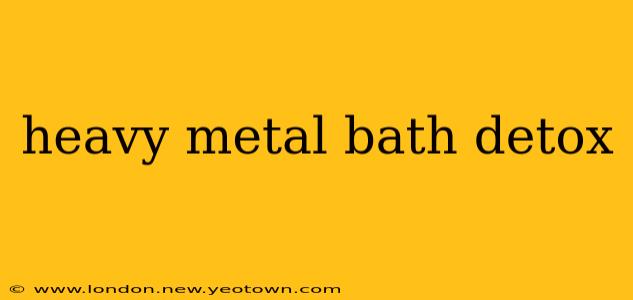The human body, a marvel of engineering, is constantly working to maintain balance. But sometimes, it needs a little help. We live in a world saturated with toxins, from the air we breathe to the food we eat. Heavy metals, insidious invaders, can accumulate in our systems, potentially impacting our health in significant ways. This is where the concept of a heavy metal bath detox comes in. But does it really work? Let's explore the science, the methods, and the potential benefits and drawbacks.
Imagine this: you’re sinking into a warm, soothing bath, feeling the tension melt away. But this isn't just any bath; this is a carefully crafted ritual aimed at drawing out heavy metals from your body. This is the promise of a heavy metal bath detox. The reality, however, is a little more nuanced.
What are Heavy Metals and Why Detox?
Heavy metals are naturally occurring elements with a high density. While some are essential for bodily functions in trace amounts (like zinc and iron), others, such as mercury, lead, cadmium, and arsenic, are highly toxic. Exposure can occur through various routes: contaminated food and water, industrial pollution, certain medications, even some cosmetics. These metals can accumulate in our tissues, interfering with cellular processes and potentially contributing to various health issues. This is why detoxification is often sought after.
How do heavy metals enter the body?
This is a question many people ask. The truth is, there are many avenues for heavy metal exposure. Think about the food you eat: contaminated seafood can contain high levels of mercury. Old paint might contain lead, and industrial pollution can release cadmium into the air and water. Even certain traditional remedies might contain heavy metals. Understanding your exposure sources is crucial.
What are the symptoms of heavy metal toxicity?
Symptoms of heavy metal toxicity can be vague and mimic other conditions, making diagnosis challenging. They can range from fatigue and headaches to neurological issues, digestive problems, and skin rashes. The severity depends on the metal, the level of exposure, and individual sensitivity. If you suspect heavy metal poisoning, consult a healthcare professional immediately. A blood test can help determine heavy metal levels.
The Heavy Metal Bath Detox Method: Fact or Fiction?
The heavy metal bath detox involves soaking in a bath infused with ingredients believed to bind to and draw out heavy metals. Popular additions include Epsom salts (magnesium sulfate), bentonite clay, and zeolite. The theory is that these substances absorb heavy metals through the skin.
Does a heavy metal bath detox actually work?
While anecdotal evidence supports the effectiveness of heavy metal bath detox, scientific evidence is limited. The absorption of heavy metals through the skin is minimal. The primary method of heavy metal excretion is through the kidneys and liver. While a bath may provide relaxation and support overall well-being, its efficacy in significantly removing heavy metals is debated.
What are the ingredients typically used in a heavy metal bath detox?
As mentioned, Epsom salts, bentonite clay, and zeolite are frequently used. Each has its purported benefits: Epsom salts are believed to improve magnesium levels, bentonite clay is a known absorbent, and zeolite is a volcanic mineral claimed to bind to heavy metals.
How often should I do a heavy metal bath detox?
There's no universally agreed-upon frequency. Some suggest once or twice a week, while others recommend less frequent use. It's crucial to listen to your body and adjust accordingly. Always start with a single session to assess your tolerance.
Beyond the Bath: Other Detoxification Methods
While heavy metal bath detox may offer some relaxation benefits, it shouldn't be considered a primary detoxification method. More effective strategies include working with a healthcare professional to identify and address underlying heavy metal exposure, supporting your liver and kidneys through a healthy diet and lifestyle, and exploring chelation therapy (a medical procedure that removes heavy metals from the body). Chelation therapy should always be performed under the supervision of a qualified healthcare professional.
Conclusion: A Holistic Approach
The human body is resilient, but it needs support. Heavy metal bath detox can be a relaxing addition to a holistic wellness routine, but it shouldn't replace professional medical guidance when addressing concerns about heavy metal toxicity. Prioritizing a healthy lifestyle, including a balanced diet rich in antioxidants, regular exercise, and stress management, forms a stronger foundation for overall detoxification and well-being. Always consult a healthcare professional before starting any new detox program, especially if you have underlying health conditions. Remember, a truly effective approach combines multiple strategies and works in harmony with your body's natural detoxification processes.

